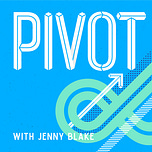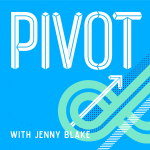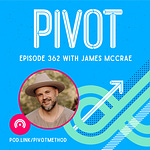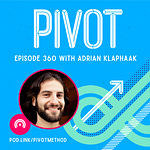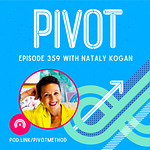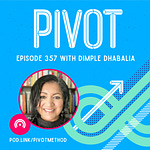Good decision-making is not about omniscience or clairvoyance—it's more about resilience, according to today’s guest, decision engineer Michelle Florendo. “Decision-making is harder than ever before, and it's not your fault,” Michelle says. “People feel like they ‘should just know’ how to decide.”
Today we’re talking about a framework more helpful than pro-con lists, tuning into your head, heart and gut; why the quality of your decision is not equal to the outcome—did good or bad things happen; keeping a decision journal to evaluate the quality of your decisions regardless of the outcome; and how to drop the guilt of “bad” past outcomes.
More About Michelle: Michelle Florendo is a decision engineer and executive coach who is passionate about teaching people how to make decisions with less stress and more clarity, from the small, consistent microdecisions over time that governs how you show up as a leader to the big macrodecisions you make about what direction to take next in business or life. Over the past decade, she has shown hundreds of driven professionals how to use the principles of decision science to grow their impact and fulfillment. She served on the inaugural coaching team for Seth Godin's altMBA, was a founding member of the Forbes Coaches Council, and helps train new coaches as a Faculty Coach at Berkeley Executive Coaching Institute. Michelle helped redesign the decision-making module in Stanford's famous Designing Your Life course and has taught courses on decision making for Stanford Continuing Studies, and hosts the podcast Ask a Decision Engineer.
🌟 4 Key Takeaways
Saying no to something “good” — What makes it good? How is it delivering the things you want? It might look good on paper to your peers or family or to society, but does it still work for you?
Every decision has three components: objectives (what is it you care about?), options (what are you choosing among), and information (about how those options might play out).
Intuition is the sum of our internal wisdom: It’s not separate; rather, it’s a quick synthesis of our inputs and rational processes. If you can’t explain a decision, remind yourself that “I just haven’t built the bridge . . . yet.”
I asked Michelle after we stopped recording what defines a high-quality decision: “Most of my colleagues from the Society of Decision Professionals agree on some version of the 6 links of decision quality. What's key to remember is that you must be able to assess your decision quality at the time you make the decision in order to avoid conflating the quality of the decision with the quality of the outcome. Finish the following sentence: ‘I can move forward at peace with this decision because...’ Maybe you can move forward feeling at peace because you clarified your objectives; maybe you took the time to generate some creative options beyond the obvious, or you recognize that it's too costly (in time, opportunity, or other resources) to collect more information beyond what you already have.”
✅ Try This Next
Tune into multiple sources of data: head+heart+body. Pro-con lists tend to mostly activate rational thinking. As an alternative, try an attractive-concerning table. Draw a 2x2 with a column for each option. What is attractive about each option? What is concerning? Look for themes that bubble up.
To reduce compare-and-despair when scrolling on social: To what degree is this [content] inspiring me versus to what degree is this making me feel bad?
Bonus: Try keeping a decision journal (here’s an example of Shaan Puri’s Decision Register).
🔗 Resources Mentioned
Articles: Stanford Decision Engineer Shares 5 Mistakes People Make When Facing Hard Choices, DEAR SUGAR: The Ghost Ship That Didn’t Carry Us
15 Ways To Help Coaching Clients View Themselves Objectively
Video: How to make a decision
People: Stanford Professor Ronald Howard
Shaan Puri’s Decision Register (listen here; access his template here)
Sarah Peck’s Startup Parent
Stanford’s Life Design Lab
Template: Michelle’s Decision Inventory Exercise
📚 Books Mentioned
Designing Your Life by Bill Burnett and Dave Evans
Thinking in Bets by Annie Duke
🎧 Related Episodes
Michelle’s Ask a Decision Engineer
My First Million: The Decision Register, Newsletter Woes and An Audience of One
Pivot: 322: Tips for Making Tough Decisions — Solo Spotlight with Sarah Young
028: Tradeoffs: 5 Things I Was Terrible At While Writing Pivot
360: 📦 Unpacking a Big Business Decision and Dissolving Related Doubts with Adrian Klaphaak
Free Time: 154: The Hard No ❌
120: Transform Your To-Do List into a Results List — Leanne’s Favorite Time-Saving System
❤️ Enjoying the show? I'd be grateful for a rating and/or review! Even better? Share this episode with a friend :)
💌 Get my curated twice monthly PivotList newsletter
✍️ Connect with me on Substack: http://substack.com/@jennyblake
💻 Check out Pivot courses on LinkedIn Learning: Figuring Out Your Next Move, Holding 1:1 Career Conversations, Managing Introverts, Coaching New Hires, and Coaching New Managers
💬 I’d love to hear what’s on your mind! Take the Pivot listener survey
☎️ Submit a question or comment for future episodes
🎧 Make sure you’re subscribed wherever you listen to ‘casts
📝 Check out full show notes at http://pivotmethod.com/361


